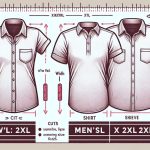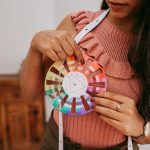Imagine pulling on a workout shirt that feels just right—breathable, dry, and comfortable—almost like it was made for your body. You might think all moisture-wicking fabrics work the same, but there’s more beneath the surface. Men’s and women’s activewear often use different fabric blends and cuts to meet unique needs. Understanding these differences can change how you choose gear for your workouts.
Table of Contents
Key Takeaways
- Men’s moisture-wicking fabrics use darker tones and straighter cuts, while women’s fabrics offer brighter colors and contoured fits.
- Men’s fabrics prioritize durability and quick drying; women’s blends emphasize softness and higher synthetic content for moisture absorption.
- Moisture-wicking technology in men’s fabrics focuses on rapid sweat dispersion, while women’s fabrics balance moisture control with enhanced breathability.
- Performance fabrics for men handle higher sweat volumes on the torso, whereas women’s fabrics optimize breathability around the chest and hips.
- Market trends show men value durability and function, while women prioritize fit, style, and moisture control in activewear choices.
Design and Style Variations in Moisture-Wicking Fabrics
While both men’s and women’s moisture-wicking fabrics serve the same functional purpose, their design and style often differ to meet distinct preferences and body shapes.
When you shop for these fabrics, you’ll notice color choices tend to vary—men’s options often lean toward darker, neutral tones, while women’s selections include brighter and more varied hues.
Fit differences are another key aspect; men’s moisture-wicking garments usually have a straighter cut to accommodate broader shoulders and a less tapered waist.
Men’s moisture-wicking gear features a straighter cut for broader shoulders and a relaxed waist fit.
In contrast, women’s designs often feature a more contoured fit, emphasizing curves for comfort and style.
These variations guarantee that you get the best combination of performance and appearance tailored to your body type and personal taste.
Differences in Fabric Composition for Men and Women
Because men and women have different physiological needs, moisture-wicking fabrics often vary in their composition to optimize performance.
When you choose moisture-wicking gear, you’ll find that fabric blends differ between men’s and women’s lines to address these unique needs.
Women’s fabrics often include higher percentages of synthetic fibers combined with natural ones to enhance moisture absorption without sacrificing softness.
Men’s fabrics might lean more toward durable synthetics designed to handle higher sweat volumes and quicker drying times.
These fabric blends are carefully engineered to balance breathability and moisture control based on typical body temperature and sweat rates for each gender.
How Moisture-Wicking Technology Works Across Genders
Understanding the fabric composition helps you see why moisture-wicking technology works differently for men and women. Manufacturers use gender specific technology to tailor fabrics to each body’s unique sweat patterns and temperature regulation.
For men, moisture-wicking fibers often emphasize rapid sweat dispersion, while women’s fabrics focus on balancing moisture control with breathability. You’ll also notice fabric durability varies; men’s garments typically use tougher weaves to handle higher abrasion, whereas women’s fabrics prioritize elasticity and fit.
Both rely on engineered fibers that pull moisture away from the skin to the fabric’s surface, promoting quick evaporation. By choosing moisture-wicking fabrics designed with gender specific technology, you get optimized comfort and performance suited to your body’s needs, without compromising fabric durability.
Performance Benefits Tailored to Men’s and Women’s Needs
When you choose moisture-wicking fabrics designed specifically for men or women, you gain performance benefits that directly address your body’s unique needs.
These fabrics consider gender specific needs like differences in sweat patterns, body heat, and fit preferences. For example, men’s fabrics often focus on managing higher sweat volumes in the torso, while women’s versions prioritize breathability and moisture control around the chest and hips.
This tailored performance guarantees you stay dry and comfortable during activity, enhancing your overall experience. By using fabrics engineered for your gender’s physiology, you prevent overheating and chafing more effectively.
Consumer Preferences and Market Trends by Gender
Choosing moisture-wicking fabrics tailored to men’s and women’s needs influences more than just comfort and performance—it also shapes buying habits and market offerings.
When you shop for activewear, you’ll notice brands use market segmentation to target men and women differently, reflecting distinct consumer buying patterns. Men often prioritize durability and function, while women may focus on fit and style alongside moisture control.
This segmentation drives companies to develop gender-specific fabric blends and designs, catering to these preferences. Understanding these trends helps you make informed choices that align with your activity level and personal comfort.
As a result, the market evolves with more specialized options, ensuring you get moisture-wicking gear that matches not only your physical needs but also your style preferences.
Frequently Asked Questions
Are There Hypoallergenic Moisture-Wicking Options Specifically for Men or Women?
You can find hypoallergenic options designed with gender-specific fabrics that cater to men’s and women’s unique skin needs. These moisture-wicking materials help reduce irritation, ensuring comfort and breathability during your workouts or daily activities.
Do Moisture-Wicking Fabrics Help Reduce Skin Irritation During Intense Workouts?
Moisture-wicking fabrics help reduce skin sensitivity and improve workout comfort by drawing sweat away from your skin. This keeps you dry, lowers irritation risk, and lets you focus on your intense workouts without distraction.
Can Moisture-Wicking Clothing Prevent Bacterial Growth and Odor Buildup?
You’ll find moisture-wicking clothing offers bacterial resistance, helping prevent bacterial growth during workouts. It also provides odor control by keeping sweat away from your skin, reducing the environment where bacteria thrive and cause unpleasant smells.
How Should I Care for Moisture-Wicking Fabrics to Maintain Their Effectiveness?
Treat your moisture-wicking gear like a delicate flower—wash in cold water, avoid fabric softeners, and air dry to preserve fabric longevity. These gentle cleaning techniques keep your clothes fresh and effective, workout after workout.
Are There Eco-Friendly Moisture-Wicking Fabric Options Available for Both Genders?
You’ll find plenty of eco-friendly brands offering moisture-wicking fabrics made from sustainable materials like recycled polyester and bamboo. These options work great for both men and women, helping you stay dry while supporting the planet.







